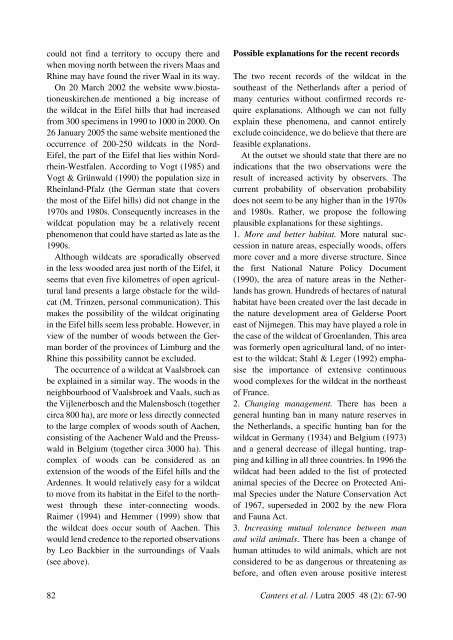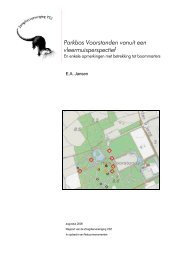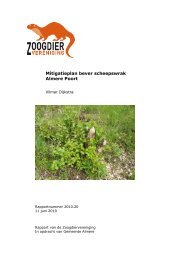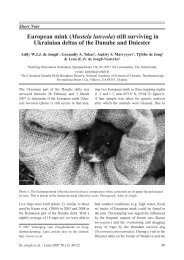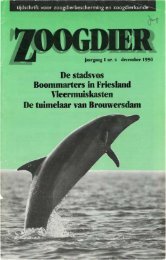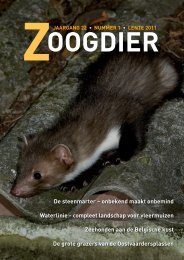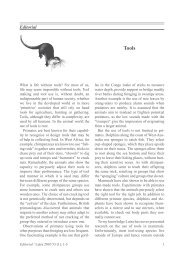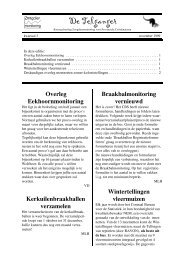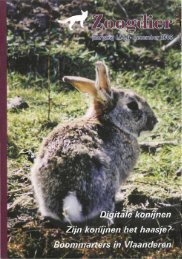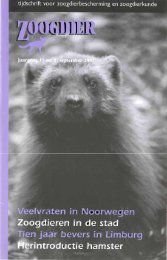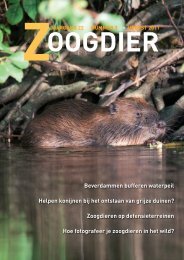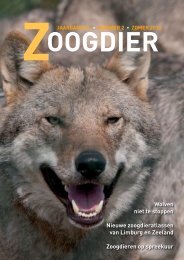binnenwerk 48-2-2005 - De Zoogdiervereniging
binnenwerk 48-2-2005 - De Zoogdiervereniging
binnenwerk 48-2-2005 - De Zoogdiervereniging
You also want an ePaper? Increase the reach of your titles
YUMPU automatically turns print PDFs into web optimized ePapers that Google loves.
could not find a territory to occupy there andwhen moving north between the rivers Maas andRhine may have found the river Waal in its way.On 20 March 2002 the website www.biostationeuskirchen.dementioned a big increase ofthe wildcat in the Eifel hills that had increasedfrom 300 specimens in 1990 to 1000 in 2000. On26 January <strong>2005</strong> the same website mentioned theoccurrence of 200-250 wildcats in the Nord-Eifel, the part of the Eifel that lies within Nordrhein-Westfalen.According to Vogt (1985) andVogt & Grünwald (1990) the population size inRheinland-Pfalz (the German state that coversthe most of the Eifel hills) did not change in the1970s and 1980s. Consequently increases in thewildcat population may be a relatively recentphenomenon that could have started as late as the1990s.Although wildcats are sporadically observedin the less wooded area just north of the Eifel, itseems that even five kilometres of open agriculturalland presents a large obstacle for the wildcat(M. Trinzen, personal communication). Thismakes the possibility of the wildcat originatingin the Eifel hills seem less probable. However, inview of the number of woods between the Germanborder of the provinces of Limburg and theRhine this possibility cannot be excluded.The occurrence of a wildcat at Vaalsbroek canbe explained in a similar way. The woods in theneighbourhood of Vaalsbroek and Vaals, such asthe Vijlenerbosch and the Malensbosch (togethercirca 800 ha), are more or less directly connectedto the large complex of woods south of Aachen,consisting of the Aachener Wald and the Preusswaldin Belgium (together circa 3000 ha). Thiscomplex of woods can be considered as anextension of the woods of the Eifel hills and theArdennes. It would relatively easy for a wildcatto move from its habitat in the Eifel to the northwestthrough these inter-connecting woods.Raimer (1994) and Hemmer (1999) show thatthe wildcat does occur south of Aachen. Thiswould lend credence to the reported observationsby Leo Backbier in the surroundings of Vaals(see above).Possible explanations for the recent recordsThe two recent records of the wildcat in thesoutheast of the Netherlands after a period ofmany centuries without confirmed records requireexplanations. Although we can not fullyexplain these phenomena, and cannot entirelyexclude coincidence, we do believe that there arefeasible explanations.At the outset we should state that there are noindications that the two observations were theresult of increased activity by observers. Thecurrent probability of observation probabilitydoes not seem to be any higher than in the 1970sand 1980s. Rather, we propose the followingplausible explanations for these sightings.1. More and better habitat. More natural successionin nature areas, especially woods, offersmore cover and a more diverse structure. Sincethe first National Nature Policy Document(1990), the area of nature areas in the Netherlandshas grown. Hundreds of hectares of naturalhabitat have been created over the last decade inthe nature development area of Gelderse Poorteast of Nijmegen. This may have played a role inthe case of the wildcat of Groenlanden. This areawas formerly open agricultural land, of no interestto the wildcat; Stahl & Leger (1992) emphasisethe importance of extensive continuouswood complexes for the wildcat in the northeastof France.2. Changing management. There has been ageneral hunting ban in many nature reserves inthe Netherlands, a specific hunting ban for thewildcat in Germany (1934) and Belgium (1973)and a general decrease of illegal hunting, trappingand killing in all three countries. In 1996 thewildcat had been added to the list of protectedanimal species of the <strong>De</strong>cree on Protected AnimalSpecies under the Nature Conservation Actof 1967, superseded in 2002 by the new Floraand Fauna Act.3. Increasing mutual tolerance between manand wild animals. There has been a change ofhuman attitudes to wild animals, which are notconsidered to be as dangerous or threatening asbefore, and often even arouse positive interest82 Canters et al. / Lutra <strong>2005</strong> <strong>48</strong> (2): 67-90


